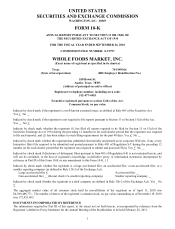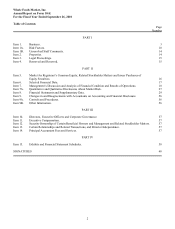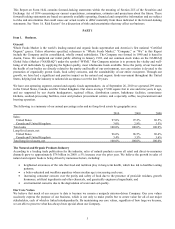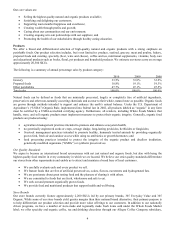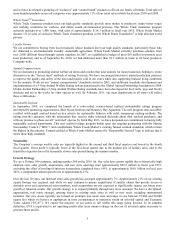Whole Foods 2010 Annual Report Download - page 17
Download and view the complete annual report
Please find page 17 of the 2010 Whole Foods annual report below. You can navigate through the pages in the report by either clicking on the pages listed below, or by using the keyword search tool below to find specific information within the annual report. 11
could be lower than our historical average for many reasons including the impact of new and acquired stores entering into the
identical store base, the opening of new stores that cannibalize store sales in existing areas, general economic conditions,
increased competition, price changes in response to competitive factors, possible supply shortages, and cycling against any
year of above-average sales results.
Our growth strategy includes opening new stores in existing and new areas and operating those stores successfully.
Successful implementation of this strategy is dependent on finding suitable locations, and we face competition from other
retailers for such sites. There can be no assurance that we will continue to grow through new store openings. We may not be
able to timely open new stores or operate them successfully. Also, we may not be able to successfully hire and train new
team members or integrate those team members into the programs and policies of the Company. We may not be able to adapt
our distribution, management information and other operating systems to adequately supply products to new stores at
competitive prices so that we can operate the stores in a successful and profitable manner.
Competitive Environment
Our competitors include but are not limited to local, regional, national and international supermarkets, natural food stores,
warehouse membership clubs, small specialty stores and restaurants. Their businesses compete with us for products,
customers and locations. In addition, some are expanding more aggressively in marketing a range of natural and organic
foods. Some of these potential competitors may have been in business longer or may have greater financial or marketing
resources than we do and may be able to devote greater resources to sourcing, promoting and selling their products. As
competition in certain areas intensifies, our results of operations may be negatively impacted through a loss of sales,
reduction in margin from competitive price changes, and/or greater operating costs such as marketing.
Fluctuations in Quarterly Operating Results
Our quarterly operating results could fluctuate for many reasons, including losses from new stores, variations in the mix of
product sales, price changes in response to competitive factors and a potential lack of customer acceptance, foreign currency
exchange rate fluctuations, increases in store operating costs, including commodity costs, that are either wholly or partially
beyond our control, possible supply shortages, general economic conditions, health care costs, legal costs, insurance costs,
extreme weather-related disruptions, including hurricanes and earthquakes, and potential uninsured casualty losses or other
losses. In addition, our quarterly operating results and quarter-to-quarter comparisons have been and may be impacted by the
timing of new store openings, construction and pre-opening expenses, the timing of acquisitions, store closures and
relocations, seasonality, and the range of operating results generated from newly opened stores. Quarter-to-quarter
comparisons of results of operations have been and may be materially impacted by the timing of new store openings.
Stock Price Volatility
In fiscal year 2010, the closing market price per share of our common stock ranged from $25.30 to $42.50. The market price
of our common stock could be subject to significant fluctuation in response to various market factors and events. These
market factors and events include variations in our sales and earnings results and any failure to meet market expectations;
changes in ratings and earnings estimates by securities analysts; publicity regarding us, our competitors, or the natural
products industry generally; new statutes or regulations or changes in the interpretation of existing statutes or regulations
affecting the natural products industry specifically; and sales of substantial amounts of common stock in the public market or
the perception that such sales could occur and other factors. In addition, the stock market in recent years has experienced
broad price and volume fluctuations that often have been unrelated to the operating performance of particular companies.
These market fluctuations also may adversely affect the market price of our common stock. Our cash flow from the exercise
of team member stock options may be adversely affected in the future by fluctuations in the market price of our common
stock.
Self-Insurance Plans
The Company uses a combination of insurance and self-insurance plans to provide for the potential liabilities for workers’
compensation, general liability, property insurance, director and officers’ liability insurance, vehicle liability and team
member health care benefits. Liabilities associated with the risks that are retained by the Company are estimated, in part, by
considering historical claims experience, demographic factors, severity factors and other actuarial assumptions. Our results
could be materially impacted by claims and other expenses related to such plans if future occurrences and claims differ from
these assumptions and historical trends.
Product Liability
There is increasing governmental scrutiny of and public awareness regarding food safety. We believe that many customers
choose to shop our stores because of their interest in health, nutrition and food safety. We believe that our customers hold us
to a higher food safety standard than other supermarkets. The real or perceived sale of contaminated food products by us
could result in government enforcement action, private litigation, product recalls and other liabilities, the settlement or
outcome of which might have a material adverse effect on our sales and operations.


